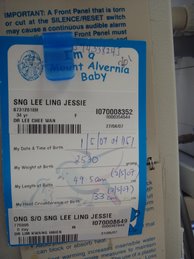A ventricular septal defect (VSD) is a hole in the part of the septum that separates the ventricles, the lower chambers of the heart. The hole allows oxygen-rich blood to flow from the left ventricle across the heart into the right ventricle instead of flowing up into the aorta and out to the body as it should.
Cross-Section of a Normal Heart and a Heart With Ventricular Septal Defect

Figure A shows the normal structure and blood flow in the interior of the heart. Figure B shows two common locations for a ventricular septal defect. The defect allows oxygen-rich blood from the left ventricle to mix with oxygen-poor blood in the right ventricle.
An infant born with a VSD may have a single hole or more than one hole in the wall that separates the two ventricles. The defect also may occur by itself or with other congenital heart defects.
Doctors classify VSDs based on the:
Size of the defect.
Location of the defect.
Number of defects.
Presence or absence of a ventricular septal aneurysm—a thin flap of tissue on the septum. This tissue is harmless and can help a VSD close on its own.
VSDs can be small or large. A small VSD doesn’t cause problems and may often close on its own. Because small VSDs allow only a small amount of blood to flow between the ventricles, they’re sometimes called restrictive VSDs. Small VSDs don’t cause any symptoms.
Medium VSDs are less likely than small defects to close on their own. They may require surgery to close and may cause symptoms during infancy and childhood.
Large VSDs allow a large amount of blood to flow from the left ventricle to the right ventricle and are sometimes called nonrestrictive VSDs. A large VSD is less likely to close completely on its own, but it may get smaller over time. Large VSDs often cause symptoms in infants and children, and surgery is usually needed to close them.
VSDs are found in different parts of the septum.
Membranous VSDs are located near the heart valves. They can close at any time.
Muscular VSDs are found in the lower part of the septum. They’re surrounded by muscle, and most close on their own during early childhood.
Inlet VSDs are located close to where blood enters the ventricles. They’re less common than membranous and muscular VSDs.
Outlet VSDs are found in the part of the ventricle where the blood leaves the heart. This is the rarest type of VSD.

No comments:
Post a Comment